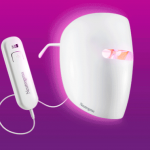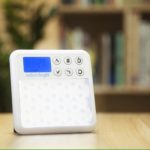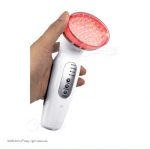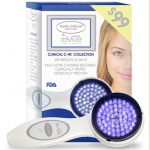What Is Acne?
Pretty simple question, right? We all know what acne is. It’s those bright red zits that always showed up at the most inopportune times when you were 16. It’s those pestering black heads all across your nose that you can never seem to squeeze out. It’s those patches of red spots showing up on your cheeks when you feel far too old for it. We know acne is, but why does our skin react the way it does?
Acne is an extremely common skin condition, according to HealthLine, a website dedicated to explaining medical conditions and the intricate details of them. In the Symptom Checker section of the website, HealthLine explains just what acne is.
“Acne occurs when the pores on your skin become blocked with oil, dead skin, or bacteria. Each pore on your skin is the opening to a follicle. The follicle is made up of a hair and a sebaceous (oil) gland. The oil gland releases sebum (oil), which travels up the hair, out of the pore, and onto your skin. The sebum keeps your skin lubricated and soft. If you develop acne, this may be because of one or more problems in this lubrication process. These possible causes include:
- Too much oil or sebum is being produced by the follicle
- Dead skin cells are accumulating in the pore
- Bacteria has built up in the pore
An overabundance of oil, a pore clogged by dead skin cells, and bacteria all contribute to the development of pimples. A zit appears when the bacteria grows in the clogged pore and the oil is unable to escape.”
(HealthLine.com)
If your skin is repeatedly being affected by your pores being plugged, you may be struggling with acne. And no, you’re alone if you’re 40 years old and have acne. Acne can affect people of all ages. From young children just entering puberty, to residents in nursing homes. Life isn’t like the movies and sometimes you just get acne.
What Causes Acne?
Acne can be caused by a wide array of things. Hormonal changes, such as puberty or pregnancy can cause temporary acne. Certain medications can increase the risk as well. Birth control pills and corticosteroids are just a couple examples. Diet also plays a major role in developing acne. Unhealthy diets, diets high in refined sugars, and diets high carbohydrates such as bread and chips make the body more susceptible.
People assume that they’re just not washing their face enough, or they need a new face cream, but most of the time that’s not the case. Hey, maybe washing your face did the trick. But for most people, that’s just not the case. Most people need some medical treatment without the crazy costs. Light Therapy is known to treat acne, especially in the form of Blue Light.
What Is Blue Light Therapy?
Blue light therapy is form of Photodynamic Therapy or Light Therapy that uses UltraViolet LED lights to treat conditions related to the skin. Blue Light Therapy is proven to have treated some skin cancers. It also aids in minimizing superficial skin lesions, acne, wrinkles, and more. Blue Light Therapy has been working miracles such as warding off skin cancer, so I think it’s safe to say it can treat the acne-causing bacteria in your pores.
How It Works…
Blue light therapy treats acne by using blue LED light treatments on a set schedule for a solid amount of time. It works by means of a blue wavelength that has been proven to reduce p. acnes, which is a bacteria in your pores. The blue LED lights penetrate deep into the skin, stimulating the bacteria in your pores, ultimately making them work against each other and self destruct. The LEDS destroy the bacteria that causes inflammation during breakouts, reduce pore size, maintain proper oil production, and promote healthy cell growth.
How To Do It…
Blue light therapy treatments can be conducted at home or in an office. Regardless of the treatment plan you choose, a set schedule must be made and followed. You can’t expect changes over night. Anything worth having takes time! In-office sessions are typically more expensive than at-home sessions, but the devices are more powerful and they’re being conducted by an expert.
Refinery29, a lifestyle blog, has a piece about blue light LED therapy treating acne. When it comes to discussing in office treatment sessions the blog reads:
“When you receive a professional blue-light session, the first thing you’ll notice is that the “light” is actually multiple diodes attached to a flat-panel apparatus that looks similar to the metallic sun shades that were popular in the ’80s (think Magda in There’s Something About Mary). You’ll be fitted with a pair of protective goggles, the panels will be placed on top of your face, and then you’ll percolate for about 20 to 30 minutes.
“Professional treatments — Somerville uses the LightSlim device at her clinic — are more powerful and can cover a much larger surface area than handheld gadgets. One of the major differences between in-office and handhelds (besides the panels) is the power source. As Dr. Grossman notes, in-office machines have a stronger battery, which makes them able to work much faster than their at-home counterparts. Because of this, in-office treatments are ideal for those with moderate to severe acne — the type that covers large patches or the entirety of the face.
Somerville says another benefit of in-office visits is that, depending on the machine used, you can attack your acne on multiple fronts. “The LightStim combo light is phenomenal for treating acne, as it has five wavelengths,” she explains. Different wavelengths have different benefits: blue light, to kill bacteria; amber light, to build collagen and strengthen the skin; two variations of red light, to reduce inflammation and promote circulation; and infrared light, to accelerate healing. “Five lights in one treatment [makes it] stronger [and] more effective,” she says.” (refinery29.com)
At home light therapy devices may not be as powerful, but they come with a long list of benefits. They are far less expensive and typically a convenient and portable size. Sessions can be conducted in the comfort of your own home and you can create your own schedule.
In Conclusion…
It’s pretty easy to understand how we feel about blue light therapy. We freaking love it. A harm free, drug free, non-invasive, alternative for killing acne? Count us in!







